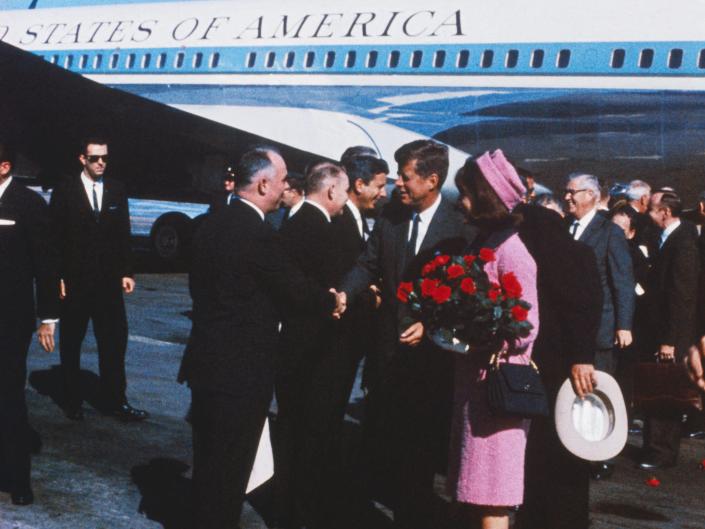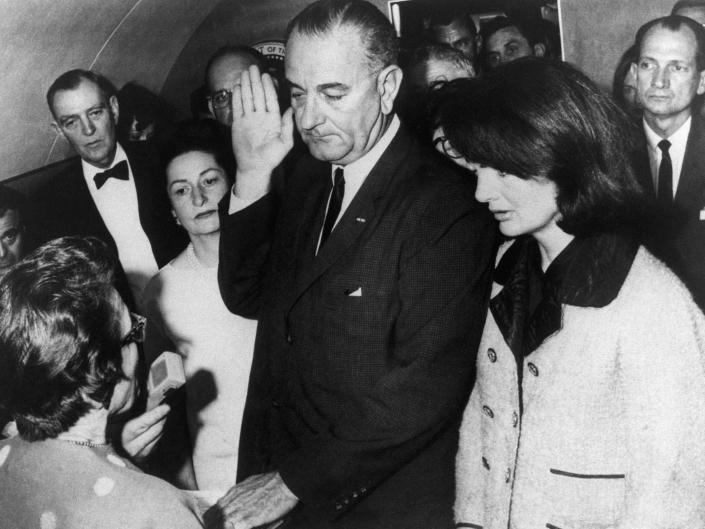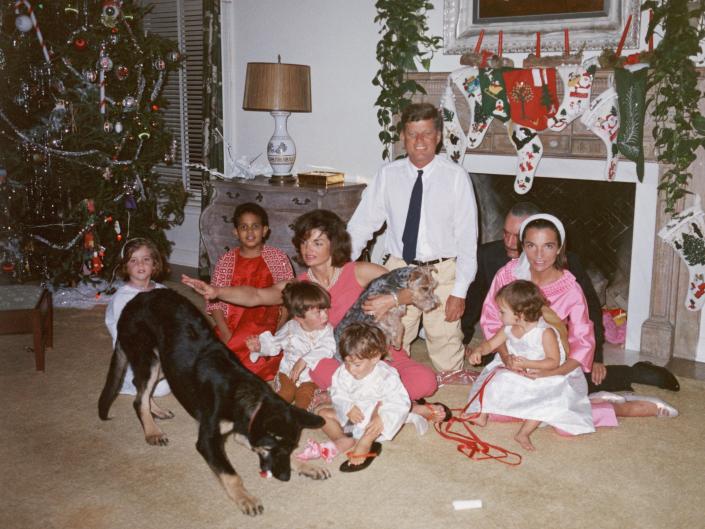
-
On the day John F. Kennedy was assassinated, Jackie Kennedy wore a replica of a pink Chanel suit.
-
Today, the suit is in a vault inside the National Archives building in College Park, Maryland.
-
It will remain hidden from public view for another 80 years.
Few garments have as much historical relevance as former first lady Jackie Kennedy’s pink suit.
On the morning of November 22, 1963, President John F. Kennedy and his wife, Jackie, arrived in Dallas, Texas, for a series of appearances. The president was later fatally shot while riding in a motorcade through the city.
The pink suit that Kennedy was wearing at the time would soon become a symbol of the tragic day that John F. Kennedy was assassinated.
“If there is a single item that captures both the shame and the violence that erupted that day, and the glamour and artifice that preceded it, it is Jackie Kennedy’s bloodstained pink suit, a tantalizing window on fame and fashion, her allure and her steely resolve, the things we know about her and the things we never quite will,” New York Times fashion critic Cathy Horyn wrote in 2013.
Here are six things you might not know about the former first lady’s outfit, from its current location to when it will be unveiled to the public for the first time.
Many think Jackie Kennedy’s pink suit was designed by Chanel, but it was actually a replica made by an American designer.

The design for the suit was pulled directly from Chanel’s Fall/Winter 1961 collection.
However, as first ladies were typically expected to wear clothing made in the United States, a replica of the suit was made for Kennedy by Park Avenue fashion house Chez Ninon, according to The New York Times. The making of the suit was authorized through Chanel’s “line for line” system, which allowed other designers to recreate the fashion house’s garments using their materials.
The wool boucle suit featured gold buttons, navy-blue piping on the sleeves, and navy lapels. It was made in a vibrant shade of pink, which wasn’t widely known at the time because most photographs and video footage from the day of the assassination were only available in black and white.
Kennedy wore the suit at least six other times before the fateful visit to Dallas.

While the outfit is famously linked to the Dallas trip, Kennedy wore the suit, including the matching pillbox hat, on numerous other occasions.
According to The New York Times, Kennedy also wore the ensemble during a 1962 visit to London and that same year to meet with the prime minister of Algeria.
The outfit was reportedly one of her husband John F. Kennedy’s favorites, and he specifically requested that he wear it on their trip, according to CR Fashion Book.
After her husband was shot, Kennedy refused to change out of the bloodstained suit until she arrived back at the White House.

After the assassination of her husband, Kennedy’s pink suit and accessories remained uncleaned and covered in splatters of blood.
According to biographer William Manchester’s account of the assassination in his book “Death of a President,” as reported by the LA Times, an aide and the president’s personal physician both suggested that the first lady change into new clothes after she had boarded Air Force One to witness the swearing in of Lyndon B. Johnson.
However, Kennedy refused, saying, “Let them see what they’ve done.”
“Somehow, that was one of the most poignant sights, that immaculate woman exquisitely dressed, and caked in blood,” Lady Bird Johnson later wrote in her diaries, according to the LA Times.
The outfit’s matching pillbox hat and white kid gloves are missing, lost during the chaos that unfolded after the assassination.

Kennedy’s pink suit, stockings, shoes, bag, and navy blouse were recovered after the assassination and placed in a dress box, which was first given to Kennedy’s mother, Janet Auchincloss, before being transferred to the National Archives.
The former first lady’s pink pillbox hat and white gloves were lost. According to the LA Times, the hat’s last known location was inside the hospital after the assassination, with strands of Kennedy’s hair caught beneath the hat pin.
“While standing there I was handed Jackie’s pillbox hat,” Mary Gallagher, the first lady’s personal secretary, wrote in her memoir. “I could almost visualize her yanking it from her head.”
Though efforts have been made to locate the hat over the years, it remains missing.
According to the LA Times, Kennedy historians told the outlet they suspect it was sold to a private collector, or “stuck away in somebody’s attic.”
The suit is now stored in a climate-controlled vault inside the National Archives building in College Park, Maryland.

According to The New York Times, the dress box containing Kennedy’s suit, stockings, and accessories arrived at the National Archives sometime before July 1964.
The box was accompanied by an unsigned note on the stationery of Kennedy’s mother, Janet Auchincloss, that read, “Jackie’s suite and bag — worn November 22, 1963.”
The Kennedy family never advised the archives on whether or not they wished the garments to be cleaned, so they remained untouched, in the same condition as they were when Kennedy changed out of them at the White House in 1963.
The items are currently stored in a secret location inside the National Archives and Records Administration complex in College Park, Maryland, in a climate-controlled vault. According to the LA Times, the temperature of the vault is kept between 65 and 68 degrees, with a humidity level of 40%, and the air is changed six times an hour.
Per her family’s request, the pink suit will not be made visible to the public until 2103 — 80 years from now and 140 years since the assassination.

According to The New York Times, after Jackie Kennedy’s death in 1994, the items were bequeathed to her daughter and sole surviving heir, Caroline Kennedy. However, they remained at the archives during this time.
In 2003, Caroline Kennedy officially transferred ownership to the National Archives with the provision that they would be hidden from public view for another 100 years.
While Jackie Kennedy’s pink suit won’t be made visible to the public until 2103, far beyond many people’s lifetimes, it will always be remembered in photographs as a symbol of one of the most tragic days in American history.
Read the original article on Insider
[ad_2]
Source link







